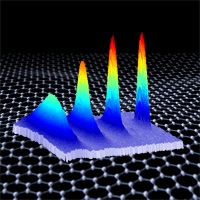30 December 2016
Being able to control a cloud of atoms, at extremely very low temperatures, has become possible thanks to the use of sophisticated laser optics. Controlling and manipulating this cloud can be a very useful tool for simulating the behavior of materials under exotic conditions.
In a recent paper published in 2D materials, ICFO researchers Dr. Tobias Graß, Prof. Leticia Tarruell, and ICREA Prof. at ICFO Maciej Lewenstein, in collaboration with Ravindra W Chhajlany from Adam Mickiewicz University and Vitorrio Pellegrini from Istituto Italiano di Tecnologia, report on the possibility of using cold atoms as a synthetic analog of graphene, a two-dimensional material formed by carbon atoms arranged in a hexagonal structure.
The team of researchers has been able to show that the atoms are made to behave in the same way as electrons in graphene do - which is strikingly different from the electronic behavior in other materials. While in metals or insulators electronic states form bands which are well separated from each other, the electronic bands in graphene touch each other in single points, the so-called Dirac points. Near such Dirac points, electrons behave as particles of zero mass (e.g. photons). A way of controlling this behavior is by the proximity of graphene to other materials.
This is where the research of this group sets it: they have shown how to use cold atoms for studying the influence of a second layer onto graphene. Depending on the strength of the coupling, additional Dirac points can be created or destroyed. The system behavior becomes most complicated when the particles interact with each other. Then, correlations between the particles must be considered, and might exhibit phenomena like superfluidity or other kinds of order. Their study shows how these correlations qualitatively change, when it becomes more likely for a particle to move between the layers rather than within a layer.
The results obtained in this study demonstrate that a rich pletora of quantum phases in an artificial graphene layer can be realized and controlled by the proximity of a second artificial lattice. The team of researchers believes that the theoretical framework developed in this study might stimulate the practical realization of synthetic multilayer crystals opening the pathway to a new research field.

Cold atoms in artificial graphene
A study published in 2D materials reports on the use of a cloud of cold atoms that can behave in the same way as graphene does.

Cold atoms in artificial graphene













